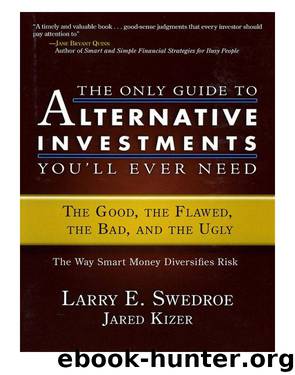The Only Guide to Alternative Investments You'll Ever Need by Larry E. Swedroe

Author:Larry E. Swedroe
Language: eng
Format: epub
Publisher: John Wiley & Sons, Ltd.
Published: 2010-05-06T16:00:00+00:00
TRANSACTIONS COSTS
Compared to passive strategies, covered-call strategies entail high transactions costs. The high turnover results in costs related to both commissions and bid-offer spreads, and possibly market impact costs as well.
AN ALTERNATIVE STRATEGY
The stated objective of any covered-call strategy is to capture the upside potential of equities, while reducing the downside risk. Yet we believe that investors can accomplish this objective in a more tax-efficient manner. Instead of writing covered calls, investors could reduce their allocation to equities and increase their allocation to fixed-income assets, while at the same time increasing their exposure to value and small-cap stocks (riskier stocks with higher expected returns). Historically, such an approach would have resulted in less volatility—as well as less downside risk—while producing returns in a more tax-efficient manner. In addition most of the potential upside is maintained. The following example illustrates this approach:
Consider two portfolios covering the period from 1973 through 2007. Portfolio A is 60 percent large-cap stocks (the Fama-French U.S. Large Cap Index) and 40 percent Lehman Brothers Intermediate Treasury Bond Index (1-10 years). Portfolio B is only 44 percent equities, and is 56 percent fixed income. The 44 percent equity allocation is split equally, with 11 percent allocated to each of large-cap stocks, large-cap value stocks the (Fama-French U.S. Large Value Index), small-cap stocks (the Fama-French U.S. Small Cap Index), and small-cap value stocks (the Fama-French U.S. Small Value Index).2 The fixed-income portion is invested in the same Lehman Brothers Treasury Bond Index. TABLE 9.1 illustrates the results.
Portfolio B, despite having a significantly lower equity allocation, produced both higher returns and a higher Sharpe ratio. Portfolio A experienced more years of negative returns and a larger loss in the worst single year. From any perspective, Portfolio B produced higher returns with less risk. Although it is never a certainty that history will repeat itself, investors seeking to improve the efficiency of their portfolios should consider this alternative, instead of a covered-call strategy.
Unfortunately, we cannot compare the above results to the outcome of a covered-call strategy, as no long-term historical data series on covered-calls strategies exists. However, a covered-call strategy might conceivably be a more prudent choice for investors who place little to no value on the lost upside potential, but place a high value on the limited downside protection that is obtained (the premiums received). In addition, because of the negative tax consequences of this strategy, an investor would need to be holding the underlying equities in a tax-advantaged location, such as a 401(k), a profit-sharing plan, or an IRA. And remember that a taxable account would be the preferred location for those investors who can choose where to hold their equities.
Table 9.1 Comparing Alternative Portfolio Strategies, 1973-2007
Download
This site does not store any files on its server. We only index and link to content provided by other sites. Please contact the content providers to delete copyright contents if any and email us, we'll remove relevant links or contents immediately.
| Analysis & Strategy | Bonds |
| Commodities | Derivatives |
| Futures | Introduction |
| Mutual Funds | Online Trading |
| Options | Portfolio Management |
| Real Estate | Stocks |
Rich Dad Poor Dad by Robert T. Kiyosaki(6414)
Pioneering Portfolio Management by David F. Swensen(6230)
How To Win Friends and Influence People by Dale Carnegie(4447)
The Money Culture by Michael Lewis(4083)
The Dhandho Investor by Mohnish Pabrai(3706)
The Wisdom of Finance by Mihir Desai(3659)
Liar's Poker by Michael Lewis(3372)
Fooled by Randomness: The Hidden Role of Chance in Life and in the Markets by Nassim Nicholas Taleb(3049)
The ONE Thing by Gary Keller(3010)
The Intelligent Investor by Benjamin Graham Jason Zweig(2995)
Mastering Bitcoin: Programming the Open Blockchain by Andreas M. Antonopoulos(2983)
Rich Dad Poor Dad: What The Rich Teach Their Kids About Money - That The Poor And Middle Class Do Not! by Robert T. Kiyosaki(2909)
How to Day Trade for a Living: Tools, Tactics, Money Management, Discipline and Trading Psychology by Andrew Aziz(2909)
Investing For Dummies by Eric Tyson(2894)
How to Win Friends and Influence People by Dale Carnegie(2864)
Market Wizards by Jack D. Schwager(2645)
The Psychology of Money by Morgan Housel(2634)
Zero Hour by Harry S. Dent Jr. & Andrew Pancholi(2614)
How to Pay Zero Taxes, 2018 by Jeff A. Schnepper(2604)
